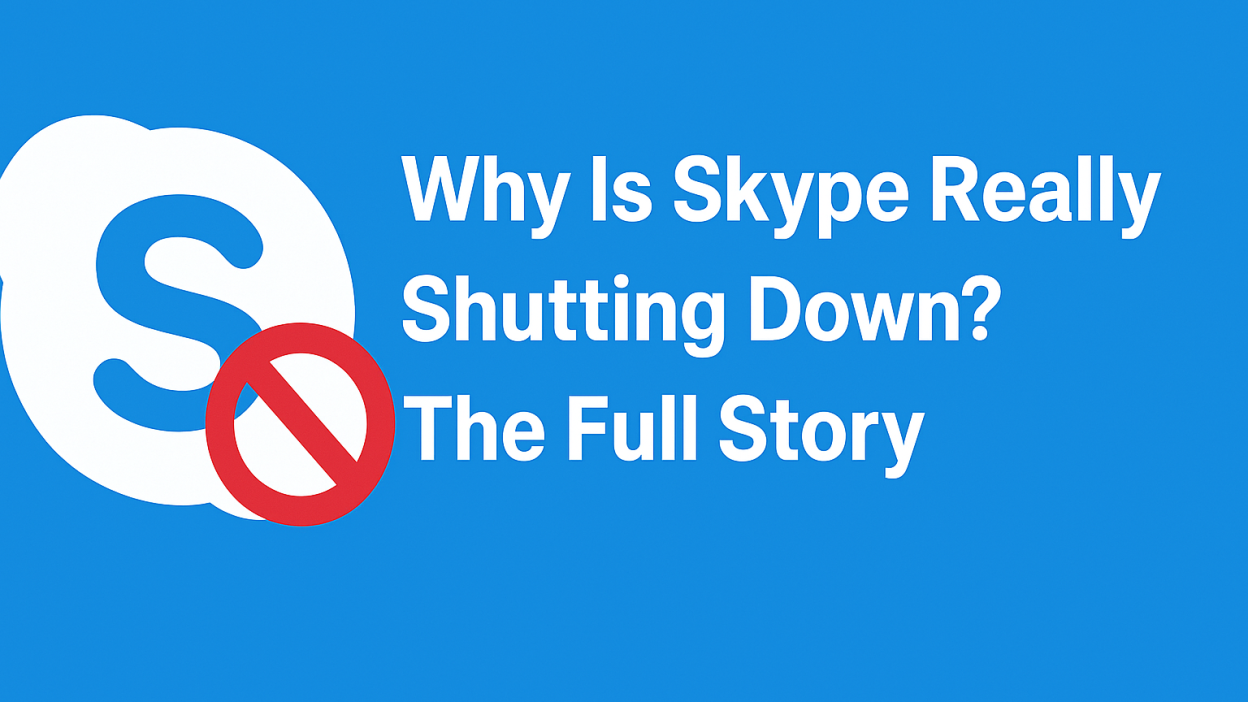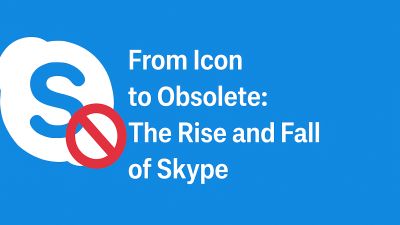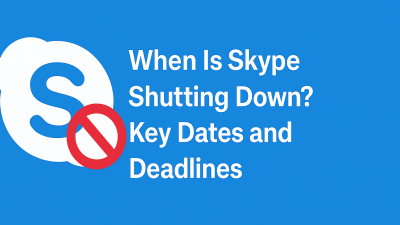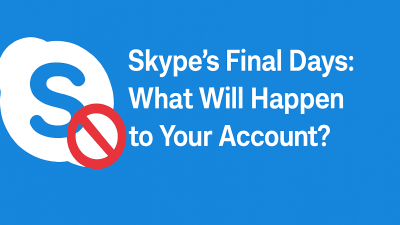When Microsoft announced Skype would be shutting down on May 5, 2025, the message was simple: we’re focusing on Teams.
That answer works if you just want the headline. But if you’re one of the people who used Skype for years maybe to stay in touch with family overseas, host freelance calls, or run your small business, that explanation feels a bit thin.
Because the truth is, Skype didn’t just get replaced.
It faded out. Slowly. Quietly. One feature at a time, one update at a time, one ignored bug at a time.
This isn’t just a story about Microsoft Teams. It’s a story about what happens when a platform that once defined digital communication fails to keep evolving and gets passed over, both by the company that owns it and the users who built their routines around it.
Skype’s Rise Was Big — But Its Decline Was Bigger
Back in the early 2000s, Skype was groundbreaking. You could talk to anyone, anywhere in the world for free. The idea of a smooth, face-to-face video chat over the internet felt like science fiction. Skype made it normal.
By 2010, Skype had hundreds of millions of users. It was a verb. “Let’s Skype later” didn’t need explaining.
So how does a product that well-known, that widely used, and that beloved fall apart?
It doesn’t happen overnight. It happens when:
-
Competitors move faster
-
User expectations change
-
And the company behind it stops pushing
Let’s look at what actually caused Skype’s slow exit.
1. Microsoft Acquired It, Then Prioritized Other Things
In 2011, Microsoft bought Skype for $8.5 billion. At the time, it made sense. Microsoft needed a stronger consumer communication tool. Skype had reach and recognition.
But over time, Microsoft’s focus shifted. Instead of investing heavily in improving Skype, it put more energy into building something new: Microsoft Teams.
This wasn’t a betrayal. It was a business decision. Teams was seen as a fresh start, better suited to remote work, Office 365, and enterprise customers.
But Skype got caught in the middle. Not fully shut down. Not fully improved. Just… stuck.
2. Skype Missed the Shift to Mobile and Modern UX
Skype’s mobile app was never its strength. It was heavy, clunky, and slow to launch, especially compared to WhatsApp or FaceTime, which were already baked into people’s phones.
While other platforms optimized for mobile-first communication, Skype kept its focus on the desktop. That worked in 2008. It didn’t work in 2020.
At the same time, Skype’s design never quite adapted to modern UI expectations. Updates were sporadic, features came and went, and users were often confused by changing layouts, missing buttons, or glitches.
People want tools that just work. Skype became a tool that used to work well.
3. Competing Platforms Did It Better — One Slice at a Time
Skype didn’t get knocked out by a single competitor. It got chipped away by dozens of them.
-
Zoom made video meetings simpler for teams.
-
WhatsApp made international voice and video calls accessible for free on mobile.
-
FaceTime made calls effortless for Apple users.
-
Discord attracted communities and casual groups.
-
Google Meet worked in-browser with no downloads or accounts.
Each of these platforms did one part of Skype’s job and did it better. Users started piecing together their communication routines across different apps. And before long, Skype wasn’t the center of anything anymore.
4. Microsoft Didn’t Market Skype — or Reinvent It
One of the clearest signs that Skype’s days were numbered was how little Microsoft talked about it.
No big campaigns. No new branding. No partnerships. No real attempt to win users back or reposition Skype for new use cases.
Instead, Microsoft went all-in on Teams — integrating it into Windows, tying it to Outlook, rolling it out to schools and companies.
Skype, once Microsoft’s flagship consumer product, became a legacy app. Not quite gone, but clearly not part of the future.
5. Users Could Feel It — Even Without the Announcement
The strange thing is, Microsoft didn’t need to say anything. People could tell.
You felt it when you opened the Skype app and saw no major updates for months. You felt it when calls glitched and nothing got fixed. You felt it when friends said “Let’s just use Zoom instead.”
Skype didn’t fail loudly. It just slowly faded out of people’s routines.
That’s what made the shutdown announcement in 2025 feel inevitable, not shocking. Most people had already moved on they were just waiting for Microsoft to make it official.
What Users Really Think — Reactions, Frustrations, and What This Teaches Us
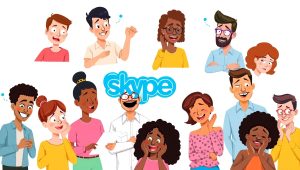
When a product shuts down, the official announcement usually focuses on what’s next, what you’ll switch to, what’s being improved, what the company is doing to “streamline” or “enhance” the experience.
But what doesn’t always get said out loud is how people feel about it. And with Skype, there’s a unique mix of reactions not just because it’s shutting down, but because of the role it played in how people connected online for over two decades.
In this part, we’re not talking about features or migration instructions. We’re looking at the emotional, social, and cultural story behind Skype’s final chapter — from how users reacted to what we can all learn when a once-essential tool fades away.
The Emotional Gap Between Users and Tech Companies
Microsoft’s announcement that Skype would be shut down in May 2025 was written like many corporate announcements: short, polished, and focused on what’s next.
But to many longtime users, it felt like something was missing.
There was no real reflection on Skype’s role in the early internet era. No mention of the millions of people who built friendships, relationships, and businesses on Skype. No acknowledgment of the nostalgia or disruption that comes with losing a platform that, for many, was the way they stayed connected to people who mattered.
And that disconnect is what stood out.
On one side, Microsoft saw Skype as an outdated tool that had been replaced.
On the other hand, users saw a familiar space, flawed, maybe, but still meaningful, being quietly shut down without a proper goodbye.
User Sentiment: A Mix of Nostalgia, Resentment, and Acceptance
As soon as the news spread, people began sharing how they really felt. It didn’t take long to see the themes emerge across Reddit threads, comment sections, and small blog posts.
1. Nostalgia from Early Adopters
For users who’ve had Skype since the early 2000s, this shutdown feels like the end of an era.
They remember:
-
Talking to family abroad before WhatsApp and FaceTime existed
-
Meeting partners online and keeping relationships alive across continents
-
Hosting job interviews and starting freelance careers
-
Being amazed that you could make a call through your computer, for free
For these users, Skype wasn’t just a product, it was a gateway to a more connected life.
2. Frustration from Longtime Users
Plenty of users stuck with Skype well past its prime. And they’re frustrated not just by the shutdown, but by how it happened.
The platform got slower. Features disappeared or didn’t work. Updates made the interface harder to use. And support became harder to find.
Many feel that Microsoft didn’t just shut Skype down; they slowly let it decay until people had no choice but to leave. Some even call it “abandonment by design.”
3. Acceptance (With a Shrug)
For newer users or those who had already moved on, the shutdown feels obvious. Skype hadn’t been a core app in their lives for years. They’d already switched to Zoom for work, WhatsApp for family, and Discord or FaceTime for casual calls.
Their reaction wasn’t sadness. It was:
“That’s still around? Makes sense they’re ending it.”
This group doesn’t feel loss, they feel like Skype quietly became irrelevant, and now it’s just catching up to reality.
Skype Meant Different Things to Different People

One reason Skype’s shutdown feels different than, say, Google Reader or Vine, is that its use cases were so varied.
For some, it was a business tool. For others, it was for family. For many, it was just… the default. A quiet piece of digital infrastructure that did its job without much fanfare.
Which means the shutdown affects people differently.
-
A remote freelancer in their 50s who used Skype to speak to clients abroad feels blindsided.
-
A college student who uses Zoom for class doesn’t think twice.
-
A small business owner who still has a paid Skype Number now needs a new solution for incoming calls.
That variety of use cases is why a “one-size-fits-all” transition plan, like “just use Teams,” doesn’t land well for everyone.
Teams Isn’t Always a Fit — And That’s Okay
Microsoft wants people to see Teams as the natural successor. But not everyone wants or needs Teams.
Teams is built around structured collaboration. Channels, meeting invites, and integrations with Microsoft 365. It’s great for organizations, schools, and workplaces. But that doesn’t mean it’s the right move for someone who just wants to chat with friends or check in with their parents on video once a week.
The emotional disconnect comes when a simple app is replaced with a more complex one, especially without a clear benefit for the average user.
For many, the right move might be Zoom, WhatsApp, Google Meet, or even MyTello if they were using Skype for low-cost international calls.
What people really want isn’t a direct replacement. They want a comfortable, dependable way to do what they’ve always done, without having to learn an entirely new system.
What Users Can Teach Us About Tech Life Cycles
When products shut down, it’s easy to focus on features. But users remind us that the real value of software isn’t just what it does, it’s how it fits into our routines, our relationships, our work, and our memories.
That’s what Skype gave people. And that’s what makes its loss more than a technical detail.
It’s also a reminder to tech companies:
If you want people to move forward, you can’t just build a better product. You have to build trust in the transition.
That means:
-
Communicating clearly
-
Acknowledging what the old product meant
-
Offering more than a corporate reason for change
Because users don’t remember the feature list. They remember how a tool helped them stay close to someone far away. Or land their first remote gig. Or talk to their kids when they were traveling for work.
That’s what’s being retired, too.
Final Reflection: Saying Goodbye to Tools That Once Felt Essential
Skype isn’t the first product to fade out, and it won’t be the last. But what makes it worth talking about is how common it was. It wasn’t niche. It wasn’t trendy. It was reliable. For a while, it was almost invisible in the best way, quietly connecting people in the background of their lives.
And that’s why this moment matters. Not because Skype was flawless. But it helped shape how the modern world communicates. So if you’re feeling a little sad, a little annoyed, or even a little relieved, that’s normal.
You’re not just watching a company retire an app. You’re watching the end of a chapter that helped define how we talk to each other.
🔍 Unique FAQ Questions
1. Why did Skype fall out of favor with everyday users before the shutdown?
Many users quietly left Skype years before the shutdown was announced due to declining performance, lack of modern features, and a better experience offered by newer apps designed for mobile and casual communication.
2. How did Microsoft’s acquisition impact Skype’s long-term development?
After acquiring Skype in 2011, Microsoft shifted its focus to other communication products like Teams. Skype’s development slowed, and it received fewer updates and marketing support, contributing to its decline.
3. Could Skype have survived if it had been rebranded or rebuilt from scratch?
Possibly. Some users believe that a modern reboot with better mobile performance, a cleaner interface, and fewer legacy issues might have saved Skype. But Microsoft chose instead to build Teams from the ground up.
4. Why didn’t Microsoft spin Skype off as a separate product instead of shutting it down?
Keeping Skype alive as a separate brand would’ve required continued investment and support. Microsoft chose to consolidate its communication tools under one ecosystem (Teams), rather than maintain two overlapping products.
5. What made Skype so hard to replace for freelancers and consultants?
Skype was uniquely valuable for solo professionals — it combined chat, screen sharing, and international calling in one place without needing a corporate setup. Newer tools are more fragmented, requiring multiple apps for the same workflow.
6. What role did COVID-era communication shifts play in Skype’s final decline?
During the COVID-19 pandemic, tools like Zoom, Meet, and Teams became the default for remote work and personal communication. Skype was largely left out of that shift, highlighting how far it had fallen behind.
7. Did Skype influence the design of newer communication platforms?
Yes, Skype introduced core concepts like free VoIP, group video calls, and screen sharing that laid the groundwork for how modern tools like Zoom, Discord, and Teams function today.

